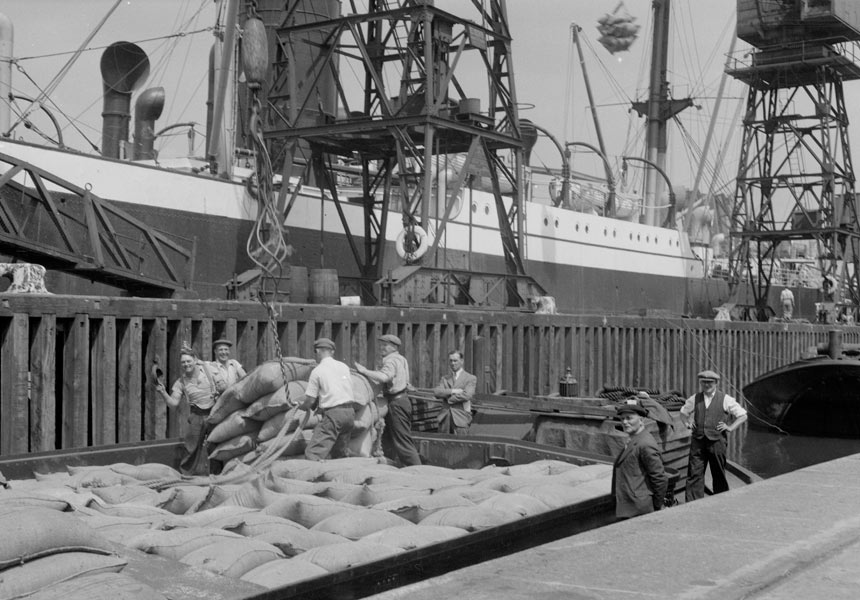By the late 1930s the port of London was handling over 41 million tons of import cargo a year - making it the most important port in Europe.
The port operation involved four elements: the loading and unloading of cargoes from ships; the storage of those commodities in warehouses; the grading and repackaging of commodities where necessary, and their subsequent sale and dispatch. Many commodities required different handling facilities and some, like mercury or iodine, required special handling either because they were dangerous or might contaminate other cargoes.
Such was the complexity and variety that a comprehensive survey is not possible here. But a study of just one dock – the London Dock, at Wapping – gives a very good idea of how the docks dealt with the very many commodities imported in the early 1930s.
The dock handled the biggest range of commodities, including canes, rubber (latex, balata and gutta percha), metals, isinglass, drugs, essential oils, tinned goods, dried fruit, pepper, gums, wax, ivory, spices, bark (for medicine and dyes), iodine, quicksilver (i.e. mercury) and wines.
The dock was organised into specialist departments that dealt with specific types of commodity.
No. 6 Warehouse handled the storage and sale of ivory, spices and medicinal barks. London was still the centre of the spice trade – a position which had been established by the English East India Company. In the 1930s London still handled 96% of the nation’s pepper and 90% of all other spices – amounting to 4,717 tons of pepper and 4,730 tons of spice in 1930 alone. In the same year around 92 tons of ivory was imported and if this was a significant decline since before the First Wold War, it was still a hugely valuable trade.
Three floors of the warehouse were devoted to spices and medicinal barks – but as with other commodities, more was stored at private riverside warehouses. In this case at Metropolitan, Butlers, Mark Browns and South Eastern Wharves.
No. 2 Warehouse handled herbs, chemicals, drugs, dyes, essential oils and isinglass. Over 1,000 tons of chemicals and drugs were stored in the PLA warehouse during the year, along with 195 tons of dyes and 160 tons of essential oils.
Warehouses 3 and 4 specialised in tinned food, (meat, fish, fruit and vegetables).In 1930 London imported nearly 174,000 tons of tinned foodstuffs, over half being tinned fruit.
Rubber, (latex, balata and gutta percha) went to No 1. Warehouse, while No 5 warehouse stored, gums, shellac and beeswax.
With many cargoes, the Port of London Authority's own employees were responsible for checking the quality of the commodity. Cases of tinned goods, for example, were checked for 'blown', pierced or rusty tins. 'Blown' tins were sent to the Port Sanitary Authority to see if the contents of the batch might be threatening to human health, while rusty tins were simply brushed clean by a boy employed for simple labouring tasks in the warehouse. Other cargoes were sorted and graded and samples drawn for delivery , on request, to potential buyers.
London's pre-eminence was shattered by the Second World War and although the level of imports was finally regained by the 1960s, the gain was in large bulk cargoes rather than in diversity. But it had been that diversity of cargo that made London’s docks and warehouses such fascinating places.








